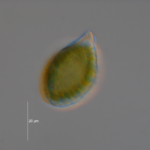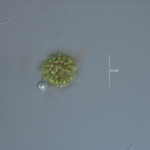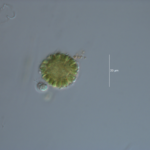Detected Species
-
HAB Species
- Diatoms
- Dinoflagellates
- Cyanobacteria
- Raphidophytes
- Haptophytes
-
Non-toxic Species
- Diatoms
- Dinoflagellates
Contact Us:
Mihaela D. Enache, Ph.D., Project Manager & Co-PI, Research Scientist I, Division of Science and Research, NJDEP (mihaela.enache@dep.nj.gov)
Ling Ren, Ph.D., PI, Research Assistant Professor, College of Science, George Mason University (lren2@gmu.edu)
Chattonella subsalsa
Morphology
Cells length: 30–50 μm, width: 20-25 μm; Flagella: two, swimming and trailing flagellum, approximately equal to cell length. Live cells show pyriform shape with a colorless tail at the posterior end, and preserved cells often appear round/lobed. Chloroplasts: numerous, green (yellowish green).
Toxins and toxicity
Produce brevetoxins; Responsible for fish and shrimp kills (Lum et al., 2021).
Ecology
Chattonella species possess various characteristics (such as phenotypic plasticity, tolerance to a wide range of temperatures, capacity for diel vertical migrations, and mixotrophy) that allow them to thrive in eutrophicated coastal waters despite the changeable conditions of these environments.
Distribution and Occurrence
Described from brackish areas rich in organic material; coastal, southeast Asia, Western Pacific. In this study, massive blooms in REF-2, PGD-2, and OMWM-2 between June and August.
References
Lum, W. M. and others. 2021. The harmful raphidophyte Chattonella (Raphidophyceae) in Western Pacific: Its red tides and associated fisheries damage over the past 50 years (1969–2019). Harmful Algae 107: 102070. doi:10.1016/j.hal.2021.102070


